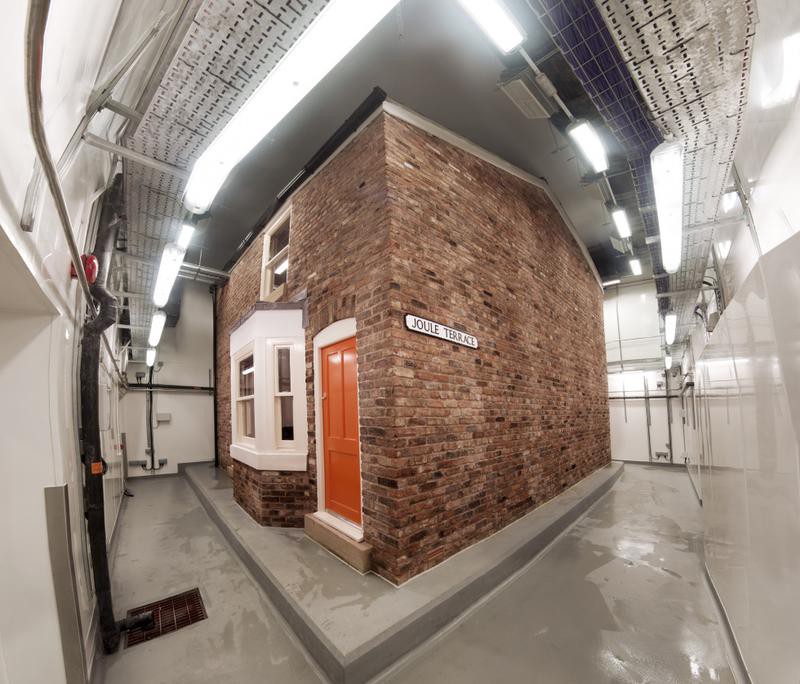

North West England isn’t known for its good weather, but researchers in an engineering lab at the University of Salford are taking the wet climate one step farther–by making it rain indoors.
It’s part of their Energy House project, designed to better understand how buildings use and lose energy. Energy efficiency is a key way we can act on climate change, and the houses around Salford–indeed the United Kingdom as a whole–are especially bad at this.
“Making buildings more efficient is the most important thing we can do,” Dr. Will Swan, senior lecturer at Salford’s School of Built Environment, said as he showed me round the Energy House lab. “Better than carbon capture and storage, or renewables, is not using the bloody stuff in the first place.”
With a grant from the European Union, Swan and his colleagues replicated one of Britain’s classically energy-inefficient houses inside an old engineering lab. It’s a standard pre-1919 “two-up, two-down” Victorian terrace. A couple of 12-foot-square rooms on top of each other, it reflects around 20 percent of the housing stock in the U.K. The key thing, however, was what the researchers built around it.
“The chamber itself is the thing that makes the difference,” Swan told me. “We can hold it within 0.5 a degree Celsius anywhere from about minus 12 to plus 30. We can rain on it and replicate wind. We’ve also got a snow machine but we haven’t used it yet.”
The researchers can play around with the temperature and humidity around the house, and use those conditions to test a range of products–insulation, heating systems or controls (e.g., the difference between a timer, a thermostat or nothing).

“There are lots of places where you can test bits of things,” Swan explained, referring to traditional materials labs. “But a whole house is a system. Things interact.” The lab house is usually furnished, for example, because that’s part of the system the researchers are testing, and they replicate the effect of neighbors with a room acting as “next door”–either over-heating or under-heating from the side.
At the same time, the lab-based conditions of the Energy House are useful. “The problem with testing whole houses in the field is usually they are occupied. The occupants can make a huge amount of difference. And the weather is hugely unpredictable,” said Swan. Understanding that unpredictability is key, he is keen to stress, speaking with enthusiasm about several projects researching energy efficiency in real communities near the university.
“We can compare one thing against the other under the same conditions. I can do one thing to the house. Test it. Then do another thing to the house. Then test is in exactly the same way. And I’ll know which one is best. And if we do the research right, we can find out why,” he said.
In its normal state, there are 300″”400 different sensors inside the house, Swan told me. I peered through the windows of the lab’s viewing platform, and through the house’s window, to see little black balls hang down from ceilings, measuring the air temperature. The researchers also record humidity, consumption of electricity, gas and water; and a series of cameras in the chamber monitor the house for heat loss from outside.
Part of what makes this setup so interesting is how flawed the example house really is. Is it a useful case study, I asked; an especially strong test for products that are used elsewhere? Swan said many of the products tested here are sold internationally, but part of the point of the research is that these things are highly context-dependent. “But we’re really keen that our next plan is something more flexible,” he added.
“The whole thing cost £2 million, but the house cost a hundred thousand. So we could knock it down and build something else that’s different,” Swan said. A highly efficient house, for example, or some building stock classic to another country. He also likes the idea of extending their expertise into another facility, something big enough to do more comparative work, and with a large enough chamber to really play around with the impact of wind or the sun (even when it’s raining outside).


How We Get To Next was a magazine that explored the future of science, technology, and culture from 2014 to 2019. This article is part of our Power Up section, which looks at the future of electricity and energy. Click the logo to read more.
